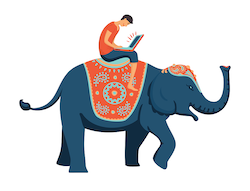The Elephant in Our Classroom Libraries
A MiddleWeb Blog
 Summertime is meant for educators to not only recharge our batteries but to reflect on our teaching practices and what we might potentially change for the upcoming school year.
Summertime is meant for educators to not only recharge our batteries but to reflect on our teaching practices and what we might potentially change for the upcoming school year.
For me, I also try to participate in as many learning opportunities as possible. We all need to keep growing in our work.
While attending a technology conference in late July, I began to think once again about the reading instructional strategies I use in my classroom and some of the most reluctant readers I’ve had – especially this past academic year, which was definitely one of the most challenging in my nearly 20-year career.
As I mulled over the past, present and future, it occurred to me that educators, including myself, tend to ignore the students in our classrooms who never pick up a book no matter what we do. Essentially, it seems to be the proverbial elephant in the room.
There’s Plenty of Good Advice
Addressing such a sensitive question can lead to difficult conversations with fellow educators. Some teachers might actually take it personally and go on the attack. I will address this later.
First, I want to make a respectful and professional nod towards a few of the great reading educators who have put in a lot of time and effort to help us become better teachers of reading and help students find the joy of reading: Kelly Gallagher, Donalyn Miller, and Laura Robb. If you haven’t read any of the books by these professionals, I highly recommend them.
Kelly Gallagher has many great professional texts available. Two of my favorites are Readacide and Reading Reasons. Readacide addresses how schools have essentially killed our students’ love of reading and what we might do to change course. Reading Reasons explores ways we can help convince students that reading is worthwhile – and includes some motivational tips.
In addition to Kelly Gallagher, a lot of educators are very aware of who Donalyn Miller is and her ideas for helping middle grades readers. The Book Whisperer is her most popular book where she describes how she motivates readers in unconventional ways by giving students choices and eliminating the use of unproductive tools like traditional worksheets.
Another popular author (her publishers include Corwin, Heinemann and Scholastic) is Laura Robb, who taught in grade 4-8 ELA classrooms for more than 40 years. Robb’s highly regarded professional text, Teaching Reading in Middle School (2nd Edition) offers strategies, lessons, models of student work, and other activities that can help lead to more successful adolescent readers. Personally, I find Robb’s literacy philosophy lines up with the work I have done with the National Writing Project (NWP).
These exceptional individuals will continue to do great work, and I applaud them for their efforts. They have a lot to offer us. However, in my opinion, there is a piece missing from the reading puzzle that’s emerged in the last two decades – during what some call the Connected Era or the Digital Age.

Over the summer, I turned to my personal learning network (PLN) on Twitter and asked how we make connections with such students. My intent was to gather feedback and other educator’s thoughts. Yet I was met at times with animosity, including teachers who didn’t want to accept the notion that there are students who just won’t pick up a novel and read it.
I was even accused of giving up on students and not trying hard enough. I felt under attack for raising an issue that simply can’t be ignored.
Here’s the Elephant
Alert teachers, literacy coaches, and other professionals have to come to an agreement that these students exist. In my mind, as we look for answers, we have to first understand that students today read differently and communicate differently than we did even 15 or 20 years ago.
I am not saying that there isn’t any value in reading books. We need a steady stream of new books and new authors – we need to do everything we can to encourage our students to read all kinds of books. But we have to look beyond books, too.
Reading is a form of communication, and if we think about it, the act of reading has shifted fairly rapidly from reading newspapers, magazines, books, and microfilm to sifting through hundreds if not thousands of websites and databases that pull at our attention from every direction.
In addition, devices have been developed (and are rapidly evolving) that enable students to carry multiple books without the burden of having a heavy backpack. And not only can they read those books, they can listen to them.
Then there is the subject of the whole range of new literacies: electronic, digital, media, computational and more. That’s where the ISTE Standards can help raise our awareness of how we must do things differently, expanding our understanding of what literacy really means.
Some of What I’m Going to Do
One of my own strategies this year – as I think back on some of the struggles I had with my upper middle school students in 2018-19 – will be to make an even bigger commitment to digital content and media literacy.
I believe there are ways we can engage those students who are simply determined to never pick up one of those wonderful artifacts we call books. Below are a few suggestions I think can work with these students and can be easily implemented into any classroom.
- KQED Learn
KQED is a nonprofit public broadcasting station (they publish the popular MindShift blog on education) that has devoted numerous hours and resources to bring media literacy to the forefront. KQED Learn strives to help teachers have free access for students so they may practice civil discourse and critical thinking while actively engaging in news, opinion and other nonfiction content.
- Students who may never grab on to a traditional novel can engage with KQED Learn where students can have serious conversations with other students across the nation about hot topics such as immigration or sexual orientation. By participating with KQED Learn, they are reading and thinking about topics that could have a direct impact on them.
- YouTube Analysis
- Let’s face it, there are a lot of students who spend time on YouTube. If you didn’t know it, YouTube is really a social media site. Our students can get sucked into watching hours of Youtube videos. Like books, there are many genres that exist on YouTube and it is a form of communication just like books. So, one way we can shift our thinking to those students who won’t pick up a novel is to find out what their favorite genre is to watch on YouTube. Then have them think about the following questions:
- What attracts you to these types of videos?
- Are there other videos outside of YouTube on this topic/subject?
- How do you know these individuals who post the videos are experts?
- Can you find other videos on the topic that aren’t true or as realistic?
- How do you know those videos are lower in quality?
- Could you create videos on this subject?
- By responding to these types of questions, students are actually processing and comprehending what they have watched and critically analyzing videos without going down the rabbit hole and wasting too much time following a trail of junk food crumbs.
- Let’s face it, there are a lot of students who spend time on YouTube. If you didn’t know it, YouTube is really a social media site. Our students can get sucked into watching hours of Youtube videos. Like books, there are many genres that exist on YouTube and it is a form of communication just like books. So, one way we can shift our thinking to those students who won’t pick up a novel is to find out what their favorite genre is to watch on YouTube. Then have them think about the following questions:
Certainly there are many other techniques we can use to capture the attention of students who don’t want to read a book. I am curious about what other educators’ ideas may be to meet the needs of adolescents who are just not interested in traditional modes of sustained reading.
Final Thoughts
We are teachers. We always have some part of our minds focused on our students. We are always thinking about how we can make them not only better students, but better citizens.
The education world is blessed with experts like Donalyn Miller, Kelly Gallagher and Laura Robb. Their instructional strategies for reading can help us stretch and grow as literacy teachers. If we pay attention to what they tell us, we can draw some of today’s students into our own love of traditional reading.
But many more students are just not going to buy into our vision of what reading needs to be about. It’s a problem we can’t ignore and hope it goes away. It won’t. If fact, it will only intensify. What we can do is think differently in a world where how we communicate is continuing to change every single day. Exponentially.




































